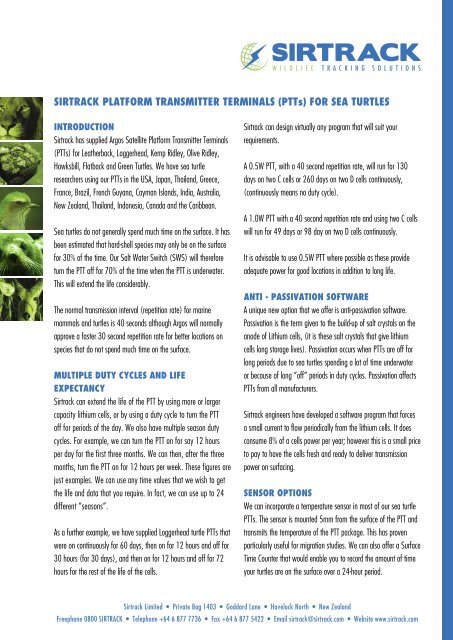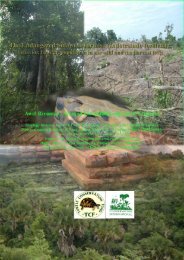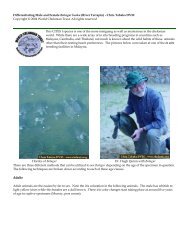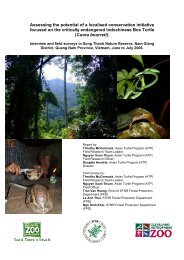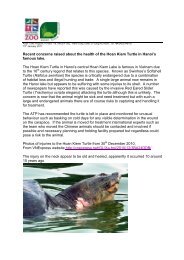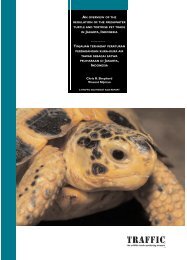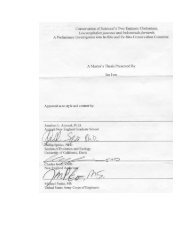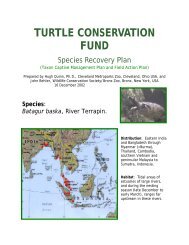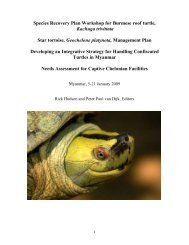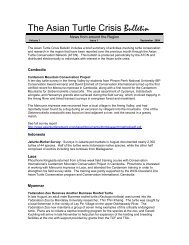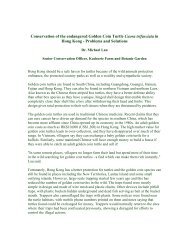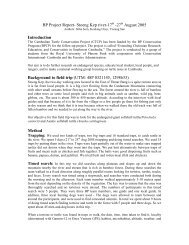Sirtrack Platform Transmitter Terminals - Asian Turtle Conservation ...
Sirtrack Platform Transmitter Terminals - Asian Turtle Conservation ...
Sirtrack Platform Transmitter Terminals - Asian Turtle Conservation ...
You also want an ePaper? Increase the reach of your titles
YUMPU automatically turns print PDFs into web optimized ePapers that Google loves.
SIRTRACK PLATFORM TRANSMITTER TERMINALS (PTTs) FOR SEA TURTLES<br />
INTRODUCTION<br />
<strong>Sirtrack</strong> has supplied Argos Satellite <strong>Platform</strong> <strong>Transmitter</strong> <strong>Terminals</strong><br />
(PTTs) for Leatherback, Loggerhead, Kemp Ridley, Olive Ridley,<br />
Hawksbill, Flatback and Green <strong>Turtle</strong>s. We have sea turtle<br />
researchers using our PTTs in the USA, Japan, Thailand, Greece,<br />
France, Brazil, French Guyana, Cayman Islands, India, Australia,<br />
New Zealand, Thailand, Indonesia, Canada and the Caribbean.<br />
Sea turtles do not generally spend much time on the surface. It has<br />
been estimated that hard-shell species may only be on the surface<br />
for 30% of the time. Our Salt Water Switch (SWS) will therefore<br />
turn the PTT off for 70% of the time when the PTT is underwater.<br />
This will extend the life considerably.<br />
The normal transmission interval (repetition rate) for marine<br />
mammals and turtles is 40 seconds although Argos will normally<br />
approve a faster 30 second repetition rate for better locations on<br />
species that do not spend much time on the surface.<br />
MULTIPLE DUTY CYCLES AND LIFE<br />
EXPECTANCY<br />
<strong>Sirtrack</strong> can extend the life of the PTT by using more or larger<br />
capacity lithium cells, or by using a duty cycle to turn the PTT<br />
off for periods of the day. We also have multiple season duty<br />
cycles. For example, we can turn the PTT on for say 12 hours<br />
per day for the first three months. We can then, after the three<br />
months, turn the PTT on for 12 hours per week. These figures are<br />
just examples. We can use any time values that we wish to get<br />
the life and data that you require. In fact, we can use up to 24<br />
different “seasons”.<br />
As a further example, we have supplied Loggerhead turtle PTTs that<br />
were on continuously for 60 days, then on for 12 hours and off for<br />
30 hours (for 30 days), and then on for 12 hours and off for 72<br />
hours for the rest of the life of the cells.<br />
<strong>Sirtrack</strong> can design virtually any program that will suit your<br />
requirements.<br />
A 0.5W PTT, with a 40 second repetition rate, will run for 130<br />
days on two C cells or 260 days on two D cells continuously,<br />
(continuously means no duty cycle).<br />
A 1.0W PTT with a 40 second repetition rate and using two C cells<br />
will run for 49 days or 98 day on two D cells continuously.<br />
It is advisable to use 0.5W PTT where possible as these provide<br />
adequate power for good locations in addition to long life.<br />
ANTI - PASSIVATION SOFTWARE<br />
A unique new option that we offer is anti-passivation software.<br />
Passivation is the term given to the build-up of salt crystals on the<br />
anode of Lithium cells, (it is these salt crystals that give lithium<br />
cells long storage lives). Passivation occurs when PTTs are off for<br />
long periods due to sea turtles spending a lot of time underwater<br />
or because of long “off” periods in duty cycles. Passivation affects<br />
PTTs from all manufacturers.<br />
<strong>Sirtrack</strong> engineers have developed a software program that forces<br />
a small current to flow periodically from the lithium cells. It does<br />
consume 8% of a cells power per year; however this is a small price<br />
to pay to have the cells fresh and ready to deliver transmission<br />
power on surfacing.<br />
SENSOR OPTIONS<br />
We can incorporate a temperature sensor in most of our sea turtle<br />
PTTs. The sensor is mounted 5mm from the surface of the PTT and<br />
transmits the temperature of the PTT package. This has proven<br />
particularly useful for migration studies. We can also offer a Surface<br />
Time Counter that would enable you to record the amount of time<br />
your turtles are on the surface over a 24-hour period.<br />
<strong>Sirtrack</strong> Limited • Private Bag 1403 • Goddard Lane • Havelock North • New Zealand<br />
Freephone 0800 SIRTRACK • Telephone +64 6 877 7736 • Fax +64 6 877 5422 • Email sirtrack@sirtrack.com • Website www.sirtrack.com
PTT OUTPUT POWER<br />
<strong>Sirtrack</strong> produces both 0.5W and 1.0W PTTs. The 0.5W PTTs are<br />
used extensively in pinniped research however, historically, sea<br />
turtle researchers have used 1.0W PTTs. The sensitivity of the new<br />
generation Argos satellites now mean that 0.5W PTTs are received<br />
at the same strength as a 1.0W PTT used to be received and<br />
researchers have found that 0.5W PTTs produce just as good results<br />
with better power management. In fact, 95% of the PTTs that<br />
<strong>Sirtrack</strong> have produced are 0.5W. The bulk of the sea turtle PTTs<br />
used within the past few years are also 0.5W units.<br />
PACKAGE FORMATS-ADULT SEA TURTLES<br />
<strong>Sirtrack</strong> provides sea turtle PTTs fully packaged and ready to<br />
deploy. All that is required is for the PTT to be activated and<br />
attached.<br />
These packages were designed with input from Col Limpus, Sally<br />
Murphy, Brendan Godley, Alan Rees and several other sea turtle<br />
researchers. They have the Salt Water Switches separated over the<br />
length of the PTT and have the antenna lifted and at the front of<br />
the package. In order to have the antenna near the head of the<br />
turtle, we have developed a protection ridge at the front of the PTT<br />
to protect the antenna from damage.<br />
Front end<br />
Adult sea turtle package with two C cells<br />
This package is a two C cell package that measures 190 mm long<br />
x 62 mm wide x 35 mm high and weighs 430 grams.<br />
Antenna<br />
protection<br />
ridge<br />
These package designs have been deployed with great success<br />
throughout the world.<br />
Front (head end)<br />
Adult sea turtle package with two D cells<br />
This package is a two D cell package that measures 190 mm long<br />
x 82 mm wide x 48 mm high and weighs 630 grams.<br />
<strong>Sirtrack</strong> Limited • Private Bag 1403 • Goddard Lane • Havelock North • New Zealand<br />
Freephone 0800 SIRTRACK • Telephone +64 6 877 7736 • Fax +64 6 877 5422 • Email sirtrack@sirtrack.com • Website www.sirtrack.com
PACKAGE FORMATS-JUVENILE SEA TURTLES<br />
<strong>Sirtrack</strong> also manufacturers smaller juvenile sea turtle PTTs powered<br />
by two, three or four AA cells. These obviously have shorter lives<br />
than the larger packages but are more suitable for smaller turtles.<br />
These packages are normally curved over their length to better suit<br />
the carapace shape.<br />
The KiwiSat 202 PTT has also been deployed on juvenile sea<br />
turtles, the smaller size makes them ideal for smaller turtles.<br />
DELIVERY<br />
Delivery is typically six weeks from confirmation of order from <strong>Sirtrack</strong>.<br />
Juvenile sea turtle package with two AA cells<br />
The two AA cell package measures 135 mm long x 32 mm wide<br />
x 18 mm high and weighs 125 grams in air. It has a continuous<br />
life of 40 days at a 45 second repetition rate; however this can be<br />
extended with a duty cycle.<br />
Juvenile sea turtle package with four AA cells<br />
The four AA cell package measures 135 mm long x 45 mm wide<br />
x 18 mm high and weighs 162 grams in air. The life is 80 days<br />
continuous, extendible with a duty cycle.<br />
<strong>Sirtrack</strong> Limited • Private Bag 1403 • Goddard Lane • Havelock North • New Zealand<br />
Freephone 0800 SIRTRACK • Telephone +64 6 877 7736 • Fax +64 6 877 5422 • Email sirtrack@sirtrack.com • Website www.sirtrack.com


